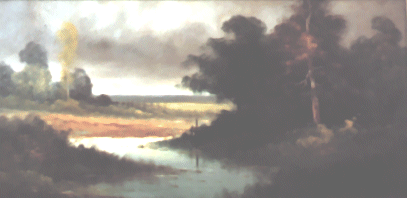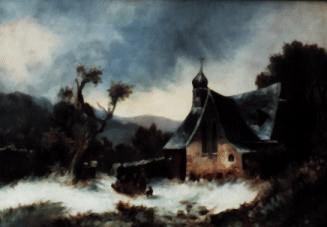|
|
|

Life and death, look closely you'll see the lone dead tree.
Another very lovely summer scene has penciled on the back, "Life and Death", showing two very large Beech trees. The one on the left is alive, A small brook flows between the trees representing "the water of life". On the right a fine large dead tree angles slightly to the left with two large branches angling left and right out of the top of the picture with about twelve short dead branches along the trunk to the crotch of the big limbs. The eye is stopped off at the top of the stream by a large boulder with a green mossy cap coming down over the left side, To the left of this large boulder among bushes appears the color of a Redbud tree (Cercis Canadensis) and to the right a white Dogwood tree (Cornus Florida). There appears to be four pools of water with small falls at the edge of the layers of rock, two falls at the upper level and one larger one at the middle level. Nine layers of rock. show at the left edge of the stream. Two large ledges show on the left side, with one boulder in the left edge of the bottom pool. Two clumps of wild flowers are in the right foreground. Seven layers of rock show at the right middleground behind the dead tree, Higher up are four more ledges with a big tree extending into the sly, which is some what flesh-toned from the Dogwood up behind the live tree branches into the cerulean blue top sky. Mr. Snyder has a wonderful way with foreground grass of fallen leaves in the autumn scenes. On the right middle ground of this picture two dead tree trunks show at the left of the ledges of rock. It would appear that their tops were broken out, This is a wonderful picture with an allegorical connotation. He recorded a half hollowed-out log, watering trough beside a country road, over-shadowed by a clump of trees and bushes with a kind of spout or trough channeling water from a spring coming out from behind a group of large boulders on the left side of the road. A post and rider style rail fence goes along the right side of the road. The road goes back through a clearing delineated on the left by a long row of trees and bushes to the juncture of the road and the fence. There is a beautiful whitish cloud effect in the sky. It is so great that these man-made effects were recorded for posterity as these things are gone forever around here in Jefferson County, Indiana.
Clifty Falls, now Clifty Fa1ls State Park, is beautifully done in many sizes and seasons, with the cliffs well defined in the upper right-hand corner of the picture with tree and bushes extending into the sky. The stream of Clifty Creek pours over the edge of the cliff in such a very delicate fashion and splashes into a spray as it hits a pool about 90 feet below. How he was able to spread that water so thin and still be visible is a real test of his patient, painstaking workmanship. This picture is the exact image of my first view of the fall, as a child, before the area became a State Park. We used to park up on Chicken Run Road, climb over the fence, and climb down the little ledges, hanging on to small trees and bushes and exploring behind the waterfall. This picture shows a beautiful bed of ferns growing wild at what is now the base of a set of wooden stairs put in by the Park Department. I am so glad that the ferns were recorded there as part of my first memories. There are trees all across the top of the picture with a bit of sky showing in the upper left corner. The rock ledges are beautifully delineated. There are fallen rocks left of the streambed with a driftwood log lying across them. This summer scene is superb craftsmanship that has never been challenged by modern day photography.
Three large still lifes are known to be extant. They are extremely well done. One has two fish hanging on a nail with a basket with fruit, vegetables, fowl, quail and ducks. The painting is signed on a letter lying on the table addressed to himself. A second has a large cut of meat standing on the left, with fruit and vegetables arranged on a table, also signed on a letter with the postmark showing the date. The third has fruit on a table with a wine bottle standing in the center surrounded by bananas, peaches and grapes.
One of Mr. Snyder's strong points is his ability to draw the viewer's eye through a picture. His forest scenes usually have an opening to the sky to bring the eye upward. Many have vestiges of dirt or gravel roads with light wheel tracks showing, or in winter scenes, sled tracks leading the eye into the distance.
Some have foreground, middleground, and background so well delineated. Many will show only footpaths, but the perspective is so well defined by diminution of subject matter and a rail fence or light, where open fields are indicated. You will find diminuted buildings, many with a wisp of smoke arising from their chimneys. All say "far away" in such graphic form. One such "faraway" house across a big open field had something white to the left of it that, at a glance, looked like a pile of white rock. It turned out to be a flock of twelve white turkeys in a space one-inch long, complete with hair-size yellow legs extending into the grass. One had wings extended high, ready to jump up and fly. Next to him was one with wings extended to the ground, also ready to jump with his neck stretched high. Two had their necks crossed and the others were in different stances of foraging, unbelievably perfect under a magnifying glass.
Some scenes have marvelous detail, as does all of his work, whether large or small. Every rock in a creekbed, every leaf on a tree or flowering weed, every railroad tie and the pebbles in between. Fallen trees so punky that you feel you could reach down and grab up a handful of it. Every highlight and every shadow in exactly the right place, impeccably done, and so true to the source of light.
Many landscapes are beautifully backlit with large trees dominating the right and left foreground, but with exquisitely detailed middle ground and background bathed in sunlight. Such an effective use of light and dark in a most beautiful composition.
His colors are as true to nature as it was possible to do with the materials available to him at that time. I find it impossible to exactly match today's colors with his of 100 years ago without the addition of some burnt umber in my work as a Conservator. Seldom can I use color directly from the tube without adulteration one way or the other but usually to the darker side of the spectrum.
I have heard many say that they "don't like Mr. Snyder's paintings, because they are so dark." I reply, "Mr. Snyder didn't paint them that way." He painted them as true to nature as it was possible for him to do. The darkening has come with age, an accumulation of dust, dirt, coal smoke, soot, evaporated cooking oil and oxidized varnish. As the original varnish dried and oxidized, it allowed air to reach the original paint, and as a new piece of silver will eventually tarnish under its protective coating, so also will oil paint tarnish.
Tobacco smoke is especially discoloring. Some that I have cleaned surely would have had "nicotine fits" had they been animate. Mr. Snyder's eyes saw nature at its best and recorded it that way for our enjoyment. In his many paintings of "The Hanging Rock" on present State Road 7 out of Madison, he recorded one layer of rock that contained several three cornered pieces that are still there 100 years later.
His oils have weathered the years better than his watercolors. The paper has browned behind the colors in nearly all that I have seen. It has been learned in more recent years that inter color paper has to be absolutely ACID FREE, and that matte papers and backing papers also must be ACID FREE.
Mr. Snyder applies a beautiful use of color in his landscape cloud effects, often using a pink highlight in a most effective way.
While he does not list Cerulean Blue in his palette, supplied by Mr. Hill. I find Cerulean Blue in most of the skies that I have restored. Many that have come to me for restoration have green sky that is merely yellowed varnish over the blue original paint that produces the green.
Another perspective ploy is the lightening or graying of receding colors from a fairly strong foreground. He is not afraid of intricate foreground, grass, weeds, fallen limbs or whatever. They are all so well done.
I seldom see birds, although one large coastal scene features a lighthouse, white cliffs and 20-odd sea birds in it. Recently, a small spring scene had a Redbird on a bare limb over a small stream.
His two best portraits are of his father and mother currently in the possession of his nephew, Mr. Frank King Snyder of Oxford, Ohio which are very well done, but no better than Mary V. Haigh in this biographer's collection or Col. Alois O. Bachman, at the Jefferson County Historical Society Museum, 615 West First St. Madison, IN,

Mr. Snyder, while known for his regional work did study in Europe where he painted this chalet.
Go to next page
| Intro page | Snyder 1 | Snyder 2 | Snyder 3 | Snyder 4 | Snyder 5 | ||||||||||||||||||||||||
| Snyder 6 | Snyder 7 | Praying Hands | Ask the Photographer | ||||||||||||||||||||||||||
 Don Wood Don Wood |
Created June 30, 1998 and modified on 6/15/03 using Homesite 5 HTML editor Link to Homesite web site |
page designed by Don Wood